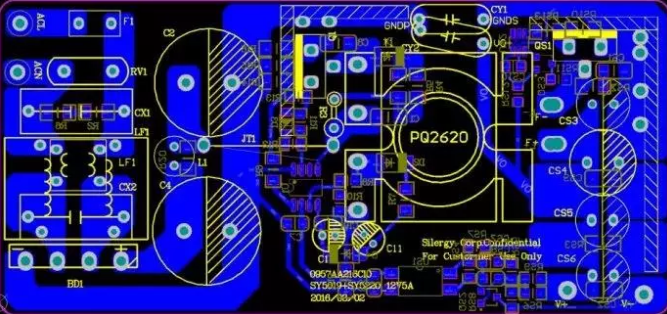Several key points of PCB design in the later stage are as follows
When a PCB has completed the layout and wiring, and the connectivity and spacing are checked and no error is reported, is a PCB completed? The answer is no, of course. Many beginners, including some experienced engineers, tend to rush through due to time constraints, impatience or overconfidence, and neglect the post inspection. As a result, some basic bugs appeared, such as insufficient line width, component label silk screen pressing on via, socket too close, signal loop, etc. Thus lead to electrical problems or process problems, serious need to re produce PCB, resulting in waste. Therefore, when a PCB has completed the layout and wiring, a very important step is the post inspection.
PCB inspection has many details of the elements, I listed some of the most basic and error prone elements, as a post inspection.
1. Component encapsulation
(1) Pad spacing. If it is a new component, you should draw the component encapsulation by yourself to ensure the appropriate spacing. The pad spacing directly affects the component welding.
(2) Via size . For plug-in components, enough allowance should be reserved for the via size, and it is generally appropriate to reserve no less than 0.2mm.
(3) Outline silk. The outline silk of the components should be larger than the actual size to ensure that the components can be installed smoothly.
(1) IC should not be close to PCB edge.
(2) the first mock exam of the same module should be placed close to the device. For example, the decoupling capacitor should be close to the power supply pin of the IC, and the components constituting the same functional circuit should be placed in a region with clear hierarchy to ensure the realization of functions.
(3) Arrange the position of the socket according to the actual installation. The sockets are all led to other modules. According to the actual structure, for the convenience of installation, the principle of proximity is generally adopted to arrange the position of the socket, and it is generally close to the edge of the board.
(4) Pay attention to the direction of the socket. All sockets have direction. If the direction is reversed, the wire should be customized. For flat socket outlets, the direction of the socket should be toward the outside of the board.
(5) There must be no components in the keep out area.
(6) The interference source should be far away from the sensitive circuit. High speed signal, high-speed clock or high current switch signal are interference sources and should be far away from sensitive circuits, such as reset circuit and analog circuit. They can be separated by paving.
3. Wiring
(1) Line width. Line width should be selected in combination with process and current carrying capacity, and the minimum line width should not be less than the minimum line width of
PCB manufacturer. At the same time, to ensure the current carrying capacity, the appropriate line width is generally selected with 1 mm / A.
(2) Differential signal line. For USB, Ethernet and other differential lines, pay attention to the same length, parallel and same plane, and the spacing is determined by the impedance.
(3) Pay attention to the return path of high-speed line. High speed line is easy to generate electromagnetic radiation. If the area formed by the routing path and the return path is too large, a single turn coil will form to radiate electromagnetic interference outward. Therefore, it is necessary to pay attention to the return path nearby when wiring. The multi-layer board with power supply layer and ground plane can effectively solve this problem.
(4) Pay attention to the analog signal line. The analog signal line should be separated from the digital signal. Try to avoid passing by the interference source (such as clock, DC-DC power supply), and the shorter the wiring, the better.
4. EMC and signal integrity
(1) Termination resistance. For high-speed line or digital signal line with high frequency and long running, it is better to connect a matching resistor in series at the end.
(2) Input signal line and connect small capacitance. The input signal line from the interface should be connected with a small capacitance of picfa class near the interface. The capacitance is determined by the strength and frequency of the signal. It should not be too large, otherwise the integrity of the signal will be affected. For low-speed input signals, such as key input, 330pF small capacitance can be selected.
(3) Drive capability. For example, the switch signal with large driving current can be driven by transistor; for the bus with large fan out number, buffer (such as 74ls224) can be added to drive.
5. Silk screen printing
(1) PCB name, time, PN code.
(2) Mark. Mark the pins or key signals of some interfaces (such as array).
(3) Component label. Component labels should be placed in appropriate positions, and dense component labels can be placed in groups. Pay attention not to place in the via hole position.
6. Others
Mark point. For PCB that needs machine welding, two to three mark points need to be added.

